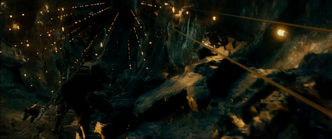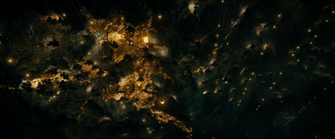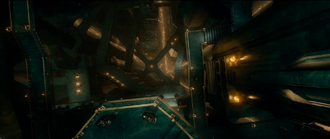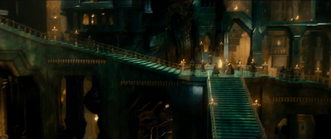No edit summary |
DarkLantern (talk | contribs) m (Reverted edits by 71.235.135.241 (talk) to last revision by - Darkchylde) |
||
| Line 1: | Line 1: | ||
{{Template:Infobox LOTR place |
{{Template:Infobox LOTR place |
||
| − | |place_name = |
+ | |place_name = Lonely Mountain |
| − | |image_place = |
+ | |image_place = Erebor-1-.jpg |
| − | |imagewidth = |
+ | |imagewidth = 260px |
| − | |image_caption = |
+ | |image_caption = Lonely Mountain drawn by Tolkien |
| − | |place_alias = |
+ | |place_alias = Erebor |
|place_description = Kingdom of Dwarves |
|place_description = Kingdom of Dwarves |
||
| − | |place_built = |
+ | |place_built = Dwarves from Grey Mountains, King [[Thror]] |
|place_realm = [[Rhovanion]] |
|place_realm = [[Rhovanion]] |
||
| − | |place_lord = [[King |
+ | |place_lord = [[King under the Mountain]]<br> |
King of Durin's folk |
King of Durin's folk |
||
| − | |place_type = }} |
+ | |place_type = Monarchy}} |
| − | {{Quote|It began long ago in a land far away to the east, the like of which you will not find in the world today. There was the city of Dale, its markets known far and wide, full of the bounties of vine and vale, peaceful and prosperous. For this city lay before the doors of the greatest kingdom in Middle-earth; Erebor, stronghold of Thrór, King |
+ | {{Quote|It began long ago in a land far away to the east, the like of which you will not find in the world today. There was the city of Dale, its markets known far and wide, full of the bounties of vine and vale, peaceful and prosperous. For this city lay before the doors of the greatest kingdom in Middle-earth; Erebor, stronghold of Thrór, King under the Mountain and mightiest of the Dwarf-lords. Thrór ruled with utter surety, never doubting his house would endure, for his line lay secure in the lives of his son and grandson. Ah, Frodo, Erebor! Built deep within the mountain itself, the beauty of this fortress city was legend. Its wealth lay in the earth in precious gems hewn from rock and in great seams of gold running like rivers through stone. The skill of the Dwarves was unequalled, fashioning objects of great beauty out of diamond, emerald, ruby, and sapphire. Ever they delved deep, down into the dark and that is where they found it, the Heart of the Mountain! The Arkenstone. Thrór named it the King's Jewel, he took it as a sign, a sign that his right to rule was divine. All would pay homage to him, even the great Elvenking Thranduil.|Bilbo Baggins}} |
| − | ''' |
+ | The '''Lonely Mountain,''' or '''Erebor,''' is a mountain northeast of [[Rhovanion]]. It is also the source of the [[River Running]] (Celduin). For many ages of [[Middle-earth]], it had been inhabited by the [[Dwarves]] of [[Durin's Folk]] or Longbeards up until the later half of the [[Third Age]] and then again in its closing years and into the [[Fourth Age]]. |
==History== |
==History== |
||
| − | === |
+ | ===Years of the Trees and First Age=== |
| + | [[File:Lmgate_als.jpg|thumb|right|200px|The entrance to the Lonely Mountain as painted by [[Alan Lee]].]] |
||
| ⚫ | The Dwarves may have still lived and mined in the mountain during the [[Second Age]] but it wasn't until the mid-Third Age that the colony had become a firmly established Kingdom of the Dwarves. After the fall of |
||
| + | It is known that the Dwarves of Durin's Folk discovered the [[Minerals and Metals|mineral]] wealth of the Lonely Mountain sometime after the awakening of the first [[Durin]]. A mining colony was soon set up and a [[Old Forest Road|road]] was laid out to connect the dwarves to their great cities from the [[Iron Hills]] and as far west as their realms and possessions in the [[Ered Luin|Blue Mountains]]. |
||
| + | ===Second and Third Ages=== |
||
| + | ====Beginnings in the Second and Third Age==== |
||
| + | |||
| ⚫ | The Dwarves may have still lived and mined in the mountain during the [[Second Age]] but it wasn't until the mid-Third Age that the colony had become a firmly established Kingdom of the Dwarves. After the fall of the ancient [[Khazad-dûm|Kingdom of Khazad-dûm]] due to the awakening of the [[Balrog]] known as [[Durin's Bane]] in [[TA 1981]]. The survivors under [[Thráin I]] followed him to the Lonely Mountain and the colony became the ancestral home of the [[King under the Mountain]]. By [[TA 1999]], it became a Dwarven stronghold, where the dwarves became a numerous and prosperous people. In this time, the dwarves became very rich and amassed a large amount of [[gold]] and [[treasure]] which included the famous jewel known as the [[Arkenstone]]. Thrain I used the Arkenstone as a sigil of his rule, and his sons and grandsons under him who were to follow. |
||
| + | [[File:The_Line_of_Durin.png|thumb|250px|The Line of Durin appears in ''[[The Hobbit: An Unexpected Journey]]''.]] |
||
For two-hundred and eleven years, the kingdom advanced, expanded, prospered and endured until [[Thorin I]] abandoned it to join his kin in the [[Grey Mountains]] (Ered Mithrin) where they began to live, and the Lonely Mountain was abandoned for three-hundred and eighty years. However, the dwarves of the Grey Mountains began experiencing attacks by the [[dragons]] that still lived in those mountains and became embroiled in a costly war against them, which forced them to abandon the Grey Mountains in [[TA 2590]]. The dwarves went their separate ways with [[Grór]] and his followers settling in the Iron Hills and [[Thrór]] and his followers settling in Lonely Mountain. |
For two-hundred and eleven years, the kingdom advanced, expanded, prospered and endured until [[Thorin I]] abandoned it to join his kin in the [[Grey Mountains]] (Ered Mithrin) where they began to live, and the Lonely Mountain was abandoned for three-hundred and eighty years. However, the dwarves of the Grey Mountains began experiencing attacks by the [[dragons]] that still lived in those mountains and became embroiled in a costly war against them, which forced them to abandon the Grey Mountains in [[TA 2590]]. The dwarves went their separate ways with [[Grór]] and his followers settling in the Iron Hills and [[Thrór]] and his followers settling in Lonely Mountain. |
||
| Line 39: | Line 45: | ||
| − | In [[TA 2941]], [[Bilbo Baggins]] and Thorin's [[Thorin and Company|company]] travel to the Lonely Mountain to [[The Quest of Erebor|regain]] the treasure Smaug had stolen. Set into the side of the mountain was a [[secret door]], five feet high and wide enough for three to walk abreast. [[Gandalf]] had managed to obtain the door's key, which would only open it when the setting sun and the last moon of autumn were in the sky together. By a fortunate coincidence, this happened just as Bilbo and the Dwarves arrived. |
+ | [[File:Desolation_-_Erebor.jpg|thumb|260px|The Dwarves overlooking the Lonely Mountain]]In [[TA 2941]], [[Bilbo Baggins]] and Thorin's [[Thorin and Company|company]] travel to the Lonely Mountain to [[The Quest of Erebor|regain]] the treasure Smaug had stolen. Set into the side of the mountain was a [[secret door]], five feet high and wide enough for three to walk abreast. [[Gandalf]] had managed to obtain the door's key, which would only open it when the setting sun and the last moon of autumn were in the sky together. By a fortunate coincidence, this happened just as Bilbo and the Dwarves arrived. |
| − | By more luck than wisdom Smaug was eventually slain — shot out of the sky with a well-aimed arrow to his only weak spot by [[Bard the Bowman]], a man of [[Laketown]] or Esgaroth — and Thorin claimed the mountain. Bard later became king of the area in the shadow of the Lonely Mountain, known as Dale. However [[Elves]] of [[Mirkwood]] and [[Men]] of Esgaroth claimed a part of the treasure, which Thorin refused to share. This led to the [[Battle of the Five Armies]], where [[Dáin II Ironfoot]] came to the aid of his cousin Thorin, but dwarves, elves, and men joined ranks together with the |
+ | By more luck than wisdom Smaug was eventually slain — shot out of the sky with a well-aimed arrow to his only weak spot by [[Bard the Bowman]], a man of [[Laketown]] or Esgaroth — and Thorin claimed the mountain. Bard later became king of the area in the shadow of the Lonely Mountain, known as Dale. However [[Elves]] of [[Mirkwood]] and [[Men]] of Esgaroth claimed a part of the treasure, which Thorin refused to share. This led to the [[Battle of the Five Armies]], where [[Dáin II Ironfoot]] came to the aid of his cousin Thorin, but dwarves, elves, and men joined ranks together with the [[eagles]] against the [[orcs]]. During the battle, Thorin was mortally injured, and the titles King under the Mountain and [[King of Durin's Folk]] passed to Dáin. |
====War of the Ring==== |
====War of the Ring==== |
||
| + | =====Battle of Dale===== |
||
| + | |||
| + | [[File:Erebor_gate.jpg|thumb|250px|The gate of Erebor.]] |
||
However, the demise of Smaug was not to be the last of Lonely Mountain's many troubles. In [[TA 3019]] on the [[March 17|17th of March]], the [[Easterlings]] from Rhûn swarmed over the Carnen (Redwater) river in a horde of soldiers, opening up a long-awaited second front that was the northern arm of the [[War of the Ring]]. The sheer force of the feared and renowned Easterlings crushed the Men of Dale and routed their forces, which had to rally back to the protection of the Lonely Mountain. |
However, the demise of Smaug was not to be the last of Lonely Mountain's many troubles. In [[TA 3019]] on the [[March 17|17th of March]], the [[Easterlings]] from Rhûn swarmed over the Carnen (Redwater) river in a horde of soldiers, opening up a long-awaited second front that was the northern arm of the [[War of the Ring]]. The sheer force of the feared and renowned Easterlings crushed the Men of Dale and routed their forces, which had to rally back to the protection of the Lonely Mountain. |
||
| Line 51: | Line 60: | ||
====Fourth Age==== |
====Fourth Age==== |
||
| − | With the restoration of the Kingdom under the Mountain the area became prosperous again. Dwarves and Men reforged their friendship. [[Dáin]] was killed during the [[War of the Ring]], and was succeeded by his son [[Thorin III Stonehelm]] who ruled well into the Fourth Age. During this time, dwarves from the Lonely Mountain helped rebuild cities in [[Gondor]] and the [[fortress]] of [[Helm's Deep]] and some went to the newly established Dwarven realm of the [[Glittering Caves]] where [[Gimli]] was [[Lord of the Glittering Caves|lord]]. Nevertheless, the Kingdom apparently continued to prosper throughout the Fourth Age. |
+ | With the restoration of the Kingdom under the Mountain the area became prosperous again. Dwarves and Men reforged their friendship. [[Dáin]] was killed during the [[War of the Ring]], and was succeeded by his son [[Thorin III Stonehelm]] who ruled well into the Fourth Age. During this time, dwarves from the Lonely Mountain helped rebuild cities in [[Gondor]] and the [[fortress]] of [[Helm's Deep]] and some went to the newly established Dwarven realm of the [[Glittering Caves]] where [[Gimli]] was [[Lord of the Glittering Caves|lord]]. Nevertheless, the Kingdom apparently continued to prosper throughout the Fourth Age.<ref>[[The Lord of the Rings]]: [[Appendix A]], III Durin's Folk</ref><ref>[[Unfinished Tales]]: [[The Quest of Erebor]]</ref> |
| + | |||
| + | ==Behind the Scenes== |
||
| + | |||
| + | [[The Hobbit (films)|The Hobbit]] (2012) was the first to show computer-generated shots of Dwarven cities, and some of the more expanded and better shots of Dwarven cities. |
||
| + | |||
| + | ==Gallery== |
||
| + | |||
| + | <gallery spacing="medium" columns="3" orientation="landscape"> |
||
| + | Erebor7.PNG|The Dwarves mining in Erebor. |
||
| + | Erebor6.PNG |
||
| + | Erebor5.PNG|The deep halls of Erebor. |
||
| + | Erebor4.PNG |
||
| + | Erebor3.PNG |
||
| + | Erebor2.PNG |
||
| + | Erebor1.PNG |
||
| + | the key to erebor.jpg|The key to the back door of Erebor. |
||
| + | the treasure of erebor.jpg|The great treasure of the city of Erebor. |
||
| + | the hobbit film Erebor.jpg|The huge door to Erebor seen from the nearby town of Dale. |
||
| + | thorin's map.jpg|Thorin's map from the Hobbit. |
||
| + | </gallery> |
||
| + | |||
| + | ==References== |
||
| + | <references/> |
||
| + | |||
| + | ==External link== |
||
| + | |||
| + | *{{TGlink|Lonely Mountain}} |
||
| + | |||
| + | [[de:Einsamer Berg]] |
||
| + | [[es:Erebor]] |
||
| + | [[fr:Erebor]] |
||
| + | [[nl:Erebor]] |
||
| + | [[pl:Erebor]] |
||
| + | [[ru:Эребор]] |
||
| + | [[Category:Lonely Mountain| ]] |
||
| + | [[Category:Mountains]] |
||
| + | [[Category:Dwarven Kingdoms]] |
||
| + | [[Category:Rhovanion]] |
||
Revision as of 03:13, 14 October 2013
- "It began long ago in a land far away to the east, the like of which you will not find in the world today. There was the city of Dale, its markets known far and wide, full of the bounties of vine and vale, peaceful and prosperous. For this city lay before the doors of the greatest kingdom in Middle-earth; Erebor, stronghold of Thrór, King under the Mountain and mightiest of the Dwarf-lords. Thrór ruled with utter surety, never doubting his house would endure, for his line lay secure in the lives of his son and grandson. Ah, Frodo, Erebor! Built deep within the mountain itself, the beauty of this fortress city was legend. Its wealth lay in the earth in precious gems hewn from rock and in great seams of gold running like rivers through stone. The skill of the Dwarves was unequalled, fashioning objects of great beauty out of diamond, emerald, ruby, and sapphire. Ever they delved deep, down into the dark and that is where they found it, the Heart of the Mountain! The Arkenstone. Thrór named it the King's Jewel, he took it as a sign, a sign that his right to rule was divine. All would pay homage to him, even the great Elvenking Thranduil."
- —Bilbo Baggins
The Lonely Mountain, or Erebor, is a mountain northeast of Rhovanion. It is also the source of the River Running (Celduin). For many ages of Middle-earth, it had been inhabited by the Dwarves of Durin's Folk or Longbeards up until the later half of the Third Age and then again in its closing years and into the Fourth Age.
History
Years of the Trees and First Age

The entrance to the Lonely Mountain as painted by Alan Lee.
It is known that the Dwarves of Durin's Folk discovered the mineral wealth of the Lonely Mountain sometime after the awakening of the first Durin. A mining colony was soon set up and a road was laid out to connect the dwarves to their great cities from the Iron Hills and as far west as their realms and possessions in the Blue Mountains.
Second and Third Ages
Beginnings in the Second and Third Age
The Dwarves may have still lived and mined in the mountain during the Second Age but it wasn't until the mid-Third Age that the colony had become a firmly established Kingdom of the Dwarves. After the fall of the ancient Kingdom of Khazad-dûm due to the awakening of the Balrog known as Durin's Bane in TA 1981. The survivors under Thráin I followed him to the Lonely Mountain and the colony became the ancestral home of the King under the Mountain. By TA 1999, it became a Dwarven stronghold, where the dwarves became a numerous and prosperous people. In this time, the dwarves became very rich and amassed a large amount of gold and treasure which included the famous jewel known as the Arkenstone. Thrain I used the Arkenstone as a sigil of his rule, and his sons and grandsons under him who were to follow.
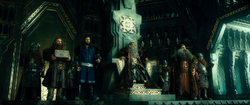
The Line of Durin appears in The Hobbit: An Unexpected Journey.
For two-hundred and eleven years, the kingdom advanced, expanded, prospered and endured until Thorin I abandoned it to join his kin in the Grey Mountains (Ered Mithrin) where they began to live, and the Lonely Mountain was abandoned for three-hundred and eighty years. However, the dwarves of the Grey Mountains began experiencing attacks by the dragons that still lived in those mountains and became embroiled in a costly war against them, which forced them to abandon the Grey Mountains in TA 2590. The dwarves went their separate ways with Grór and his followers settling in the Iron Hills and Thrór and his followers settling in Lonely Mountain.
Rebuilding
At some time later, the Lonely Mountain again became a home and kingdom of the Dwarves that was of greater prestige than ever before with the Dwarves of that time becoming highly skilled in mining, blacksmithing, metalwork, metallurgy, masonry and stonework, and there was great demand for their work by the surrounding peoples. The Men of the Wilderland established Dale and established a very close trade and culture relationship with the Dwarves of the mountain, and men and their sons were eager to learn their skills. Unfortunately, it was this prosperity that attracted Smaug to the mountain.
Erebor under Siege
Whilst Thorin Oakenshield was one day out hunting in TA 2770, Smaug came from the mountains as a young dragon, and took over the mountain, hoarding all the gold. Thráin II and several companions escaped by (as was later discovered) a secret door. For many years, the dwarves have lived in exile in the Blue Mountains until, by a chance meeting, Gandalf the Grey met Thorin Oakenshield, and they planned to reclaim the mountain. This is told in detail in The Quest of Erebor and described by Tolkien's song, "Far Over the Misty Mountains Cold."
The Quest of Erebor
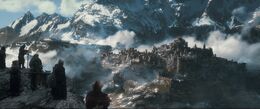
The Dwarves overlooking the Lonely Mountain
In TA 2941, Bilbo Baggins and Thorin's company travel to the Lonely Mountain to regain the treasure Smaug had stolen. Set into the side of the mountain was a secret door, five feet high and wide enough for three to walk abreast. Gandalf had managed to obtain the door's key, which would only open it when the setting sun and the last moon of autumn were in the sky together. By a fortunate coincidence, this happened just as Bilbo and the Dwarves arrived.
By more luck than wisdom Smaug was eventually slain — shot out of the sky with a well-aimed arrow to his only weak spot by Bard the Bowman, a man of Laketown or Esgaroth — and Thorin claimed the mountain. Bard later became king of the area in the shadow of the Lonely Mountain, known as Dale. However Elves of Mirkwood and Men of Esgaroth claimed a part of the treasure, which Thorin refused to share. This led to the Battle of the Five Armies, where Dáin II Ironfoot came to the aid of his cousin Thorin, but dwarves, elves, and men joined ranks together with the eagles against the orcs. During the battle, Thorin was mortally injured, and the titles King under the Mountain and King of Durin's Folk passed to Dáin.
War of the Ring
Battle of Dale
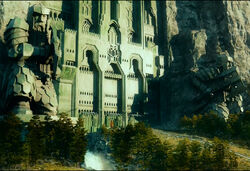
The gate of Erebor.
However, the demise of Smaug was not to be the last of Lonely Mountain's many troubles. In TA 3019 on the 17th of March, the Easterlings from Rhûn swarmed over the Carnen (Redwater) river in a horde of soldiers, opening up a long-awaited second front that was the northern arm of the War of the Ring. The sheer force of the feared and renowned Easterlings crushed the Men of Dale and routed their forces, which had to rally back to the protection of the Lonely Mountain.
The Dwarves and Men fought a pitched battle against the hated invaders, eventually emerging victorious over their vaunted opponents. The impregnable gates and walls of the Lonely Mountain, furnished and worked extensively with advanced, complex and intricate Dwarven stonework, defense planning and smith-work, easily withstood the technologically advanced siege equipment of the Easterlings. The Lonely Mountain itself was a key strong-point and gave its defenders great tactical leverage against the attackers, being able to shoot arrows and fling stones down below in reprisal. The many years invested in improving the Lonely Mountain's defenses have paid off, and the defenders lasted the Easterlings out for a siege. The Easterlings then withdrew, suffering disproportionate casualties because of their botched campaign and their difficulty in combating against the advanced Dwarven technology, weapons, armor and defenses.
Fourth Age
With the restoration of the Kingdom under the Mountain the area became prosperous again. Dwarves and Men reforged their friendship. Dáin was killed during the War of the Ring, and was succeeded by his son Thorin III Stonehelm who ruled well into the Fourth Age. During this time, dwarves from the Lonely Mountain helped rebuild cities in Gondor and the fortress of Helm's Deep and some went to the newly established Dwarven realm of the Glittering Caves where Gimli was lord. Nevertheless, the Kingdom apparently continued to prosper throughout the Fourth Age.[1][2]
Behind the Scenes
The Hobbit (2012) was the first to show computer-generated shots of Dwarven cities, and some of the more expanded and better shots of Dwarven cities.
Gallery
References
- ↑ The Lord of the Rings: Appendix A, III Durin's Folk
- ↑ Unfinished Tales: The Quest of Erebor

